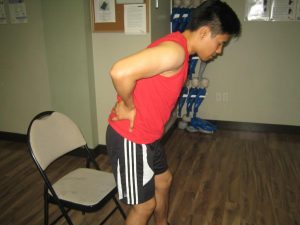A herniated disc is simply a slipped or ruptured disc in the neck or lower back. A disc is herniated or ruptured once part of the central nucleus drives through the exterior edge of the disc and towards the spinal canal which places pressure on the nerves. Remember that the spinal nerves are highly sensitive to even minimal pressure that can result to pain, weakness or numbness in one or both legs.
Risk factors
Among children and young adults, the discs have high water content. Due to the aging process, the water content in these discs drops and they become less flexible. These discs start to shrink and the spaces in between the vertebrae narrows down. Certain conditions that can weaken the disc include the following:
- Smoking
- Incorrect lifting techniques
- Engaging in repetitive strenuous activities
- Excess body weight that adds stress on the discs
- Sudden pressure
What are the symptoms?
Lower back
Many individuals experience low back pain at some point in their lives. The pain alone is not enough to recognize a herniated disc. A doctor should be consulted if back pain is brought about by a fall or direct blow to the back. The usual indication of a herniated disc is sciatica or sharp, shooting pain that radiates from the buttocks down the back of one leg due to compression on the spinal nerve.
Other signs and symptoms include the following:

- Weakening in one leg
- Burning pain focused in the neck
- Tingling or loss of sensation in one leg or buttock
- Loss of bowel or bladder control
Neck
Similar with the lower back, neck pain is also common. Once pressure is placed on a nerve in the neck, it triggers pain in the muscle in between the shoulder and the neck. This pain usually radiates down the arm and even cause headaches in the back part of the head. The other symptoms that manifest are similar in cases where the lower back is involved.
Management
The treatment for a herniated disc does not require surgery. The back or neck pain typically resolve in a gradual manner with similar measures such as:
- Adequate rest
- Over-the-counter pain medications
- Other medications such as muscle relaxants, anti-inflammatory drugs and analgesics
- Application of a cold compress or ice pack for several times throughout the day for no more than 20 minutes at a time.
- Application of heat can be started once the spasms settle
Any physical activity must be limited particularly lifting and bending forward. This will ensure that the symptoms do not recur. When the lower back is involved, exercises are beneficial in strengthening the back and abdominal muscles. For the neck, exercises or traction are also beneficial. The best way to avoid future episodes of pain is to learn how to correctly stand, sit and lifting objects.
Disclaimer / More Information
The information posted on this page on – is for learning and educational purposes only. To learn to – register for first aid training at one of our training centers located throughout Canada. The training centers are located in Edmonton, Calgary, Vancouver, Kelowna, Surrey, Winnipeg, Toronto, Ottawa and Halifax.

